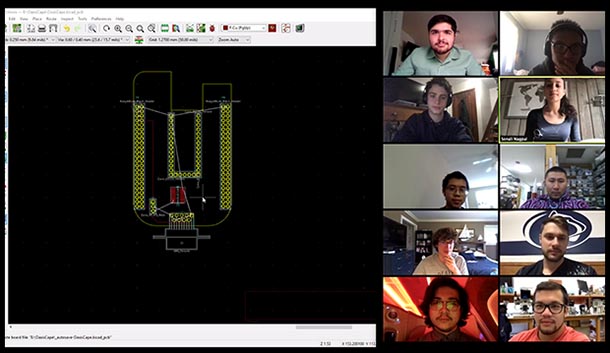
Student Space Program Laboratory students, in a virtual teaming mode, discuss the design of a component of Oasis, an instrument to be used to measure the elemental composition of the soil in permanently shadowed regions on the moon. IMAGE: PROVIDED BY ALVARO GUERRA
NASA selects Penn State student team to build technology for lunar missions
3/23/2020
By Sarah Small
UNIVERSITY PARK, Pa. — Penn State students from the Student Space Programs Laboratory (SSPL) comprise one of eight university teams recently selected by the National Aeronautics and Space Administration (NASA) to develop new technology to study the surface of the moon.
NASA selected the teams through their Breakthrough, Innovative and Game-changing (BIG) Idea Challenge, which asked university teams to “submit robust proposals for sample lunar payloads that can demonstrate technology systems needed to explore areas of the moon that never see the light of day,” according to NASA’s website. The technology developed by the winning teams could be used by NASA’s Artemis Program, which has the goal of landing the first woman and next man on the moon by 2024 and developing a sustained presence on the moon by 2028.
Through the BIG Idea Challenge, in conjunction with the Space Grant Project, NASA awarded a total of nearly $1 million to the eight university teams, with Penn State’s team receiving $145,933 for their project.
“We are all very excited about this opportunity and being a part of the Artemis mission,” said Alvaro Guerra, a Penn State senior majoring in physics and the project manager and science lead for this project. “Our mission will focus on searching for water at the moon’s southern pole. Finding a source of water will allow us to have permanent settlements on the moon.”
Guerra and his teammates from Penn State’s SSPL, which is a faculty-directed, student-run research lab housed in the Department of Electrical Engineering but open to students in other disciplines, are developing an instrument called Oasis. Oasis will be used to measure the elemental composition of the soil in permanently shadowed regions on the moon.
Oasis will employ a method known as light-induced breakdown spectroscopy, which uses a laser and a spectrometer controlled by an onboard flight computer, to determine the location and concentration of resources, such as water ice. This information will allow for on-site resource utilization, which will be critical to maintaining a presence on the moon.
“The challenge given to our students to contribute to NASA’s goals for Artemis is an amazing opportunity for them to learn how space systems are designed and built to meet mission objectives,” said Sven Bilén, director of SSPL, head of the School of Engineering Design, Technology, and Professional Programs and professor of engineering design, electrical engineering and aerospace engineering. “It is a challenge I know they will meet.”
The design environment for the students, however, has changed significantly in the month since the funded was awarded. The University announced that all instruction will occur via remote-learning and students were not to return to campus after spring break. The team recently met with representatives of the BIG Idea Challenge, who assured them that they understand these challenges, yet asked the team to continue their effort. Rising to yet another challenge, the students have developed a mitigation plan and are continuing their efforts via remote teaming.
“It is certainly very exciting to be a part of this project, especially being one of the few to see it grow from a concept on paper to getting funding from NASA to building the actual system,” said Normen Yu, a first-year student who plans to major in computer science and the command and data handling lead for the project. “As a first-year student in computer science, I am humbled by this opportunity.”
Jesse McTernan, assistant teaching professor of engineering design and associate director of SSPL, applauded the students and their work ethic, especially in light of the rapidly changing circumstances.
“I’m impressed with how hard the students worked on the proposal,” McTernan said. “They adapted quickly, assumed leadership roles, took the initiative, and got it done. I’m proud to be part of this team. I’m also honored to contribute to a lunar payload that could be part of the first steps to human life on the moon. How cool is that!”
Members of the team will travel to the 2020 BIG Idea Forum to present their prototypes, tentatively scheduled for fall of 2020.



